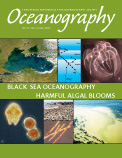First Paragraph
The Black Sea, a nearly enclosed and isolated environment, has suffered from severe ecological changes during the last three decades. It has been converted from an oligotrophic (less than 100 grams of organic carbon per meters squared per year [g C/m2/yr]) system prior to the 1970s (the pre-eutrophication phase) to a eutrophic (300 to 500 g C/m2/yr) system over the subsequent two decades (the eutrophication phase). The Black Sea has been called the largest eutrophic, or even hypertrophic (greater than 500 g C/m2/yr), water body in the world (Arai, 2001), even though there is a great deal of spatial heterogeneity over the basin. Several factors may play a role in these changes: excessive nutrient and pollutant input (Mee, 1992; Zaitsev and Mamaev, 1997), outbursts of the alien ctenophore species Mnemiopsis leidyi (Shiganova, 1998; Kideys and Romanova, 2001; Kideys, 2002; Kideys et al., this issue), overfishing (Prodanov et al., 1997; Daskalov, 2002; Gucu, 2002), and climate impacts on the physical structure (Daskalov, 2003; Oguz, this issue). Bilio and Niermann (2004) provided a comprehensive assessment of various factors responsible for the ecosystem transformations. A general implication of all these studies is that the complexity of ecological changes result from the concomitant roles of anthropogenic inputs and climatic forcing. Identification of possible future changes and mitigation of the negative impacts of the deterioration require understanding the relative influence of these individual contributions.

